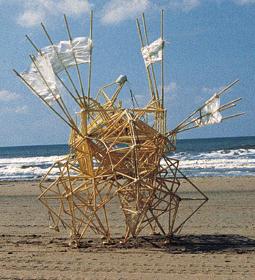
Theo Jansen’s Strandbeests are a strange combination of primitive robots and kinetic sculptures, but he calls them a new form of life. Assembled from long pneumatic tubes, these mesmerizing creations roam the dunes of Jansen’s native Dutch beaches by using stored air pressure generated by wings on their backs to move their limbs. They’re incredible looking so it’s no surprise that they’ve inspired a huge number of imitations. Search for Jansen’s name in YouTube, Vimeo, or any video sharing service and you’ll find RC robots, paper constructions, and wooden replicas of Strandbeests. There’s something about that way these lifeforms walk that is simply too enthralling to ignore. We have a multitude of videos for you, including plenty of Jansen’s original work. You’ve got to see these things, even the imitations are eerily thrilling to watch.
While some Strandbeest imitations use electricity and robotics, Jansen’s original creations aren’t intelligent, they contain no computer circuits, and they don’t use electricity. Yet the way they move is so reminiscent of the undulation of real animals that you can’t help but think these things might be alive. This is an entirely new tact on the creation of artificial life. Rather than complex mimicry of the human brain, the creation of artificial general intelligence, or the genetic engineering of single celled organisms, we just have mechanisms that move on wind power and can change their behavior based on the environment. The following is my favorite: a two ton steel and fabric monster over 15 feet tall named Animaris Rhinoceros:
Jansen’s been designing his beach roving robots since 1990, but it really wasn’t until a few years ago that he started becoming widely known around the world. In 2007 he spoke at the TED conference to introduce his Strandbeests and demonstrated their unique gait (3:55), primitive sensors (5:40), and counting mechanisms (6:40) all based on mechanics and air pressure. Check it out:
Filmmaker Alexander Schlichter has created a documentary about this work called Strandbeesten. The trailer gives you the impression that Jansen is something of a mad genius. He builds his creations in his workshop, straps them to his car for transport, and releases them into the wild.
While Jansen actually has to take extensive care to preserve and direct his Strandbeests, his ideas have already flourished on their own. There are more sculptures, robots, and models inspired by Jansen’s work that you can watch in a day. Jansen creations have a unique way of walking that keeps their hip level while their feet move. In the TED talk, this was heralded as a reinvention of wheel. It definitely gives Strandbeests a distinct appearance as they move. It’s that appearance (and the mechanics behind it) that are the unifying factor for Jansen imitations. The most common copy is a remote controlled robot that moves like a Strandbeest without all the reliance on wind and air pressure. There’s also a few that work automatically but not with any seeming intelligence.
There’s an entire subgroup of Jansen imitators that simply try to replicate his work without any automation. Creators assemble models of the Jansen locomotion system and then just articulate it using their hands. These replicas come in wood, metal, even paper. Some are content making computer generated models of Jansen’s work.
A few have attempted to recreate Strandbeests more true to form by using pipes and wind energy.
The Jansen locomotion technique, legs that walk while keeping the hip level, is truly incredible to watch. Most of the fascination for his work probably comes from the creepy and life like movement that this creates. Still, I get the impression that, to Jansen, the Strandbeest project is more about philosophy than locomotion. He talks about creating herds of his ‘organisms’, and giving them mechanical reasoning to help them survive in a wild environment. Undoubtedly, if he could find a way to have them self-replicate, he would.
I wonder what will happen when the engineers designing modular robots and nanotechnology systems start thinking like Jansen. While pipes and air pressure may never become autonomous, microscopic machines could. In that field, the simple mechanical life form could really work. We talk about artificial intelligence and robotic life joining humanity one day, but what if we start to create life that is intentionally primitive, with simple programming and no apparent duties. Jansen’s work makes me wonder if the first artificial lifeforms won’t be created to solve a problem; they’ll just be made to look amazing.
Image: Theo Jansen, Strandbeest



